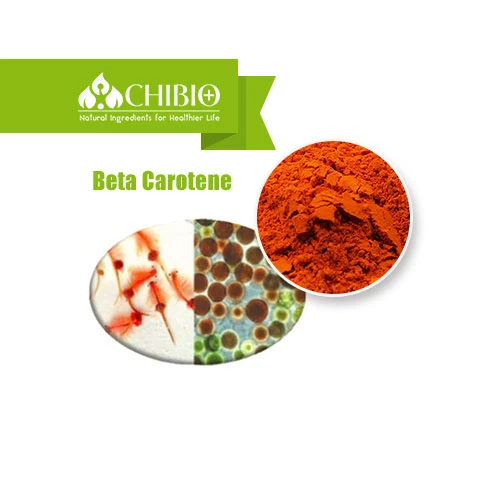Beta Carotene
Beta Carotene
Additional information
| Product Name | Beta-Carotene |
|---|---|
| Source | Synthetic |
| Specifications | ✅ Beta-Carotene Powder 10% – Water-dispersible, commonly used in food & beverages. |
| Main Benefits | 👁 Supports Eye & Vision Health |
| Main Applications | Functional Foods & Beverages |
Product Details
Beta-Carotene – The Natural Source of Vitamin A & Antioxidant Power

1. Introduction
Beta-Carotene is a provitamin A carotenoid with powerful antioxidant properties, widely used in food, pharmaceuticals, cosmetics, and animal nutrition. It provides natural pigmentation, immune support, and eye health benefits.
Chibio Biotech offers three types of synthetic Beta-Carotene, each with different solubility, stability, and applications:
✅ Beta-Carotene Powder 10% – Water-dispersible, commonly used in food & beverages.
✅ Beta-Carotene Beadlet 20% – Encapsulated for improved stability & bioavailability.
✅ Beta-Carotene 98% (Oil-Soluble) Powder – High-purity form, ideal for oils, cosmetics, and pharmaceuticals.
2. Types of Beta-Carotene & Their Applications
| Type | Form | Solubility | Best Applications |
|---|---|---|---|
| Beta-Carotene Powder 10% | Fine Powder | Water-dispersible | Functional foods, beverages, dairy products |
| Beta-Carotene Beadlet 20% | Microencapsulated Beadlets | Water-dispersible | Dietary supplements, feed additives, pharma formulations |
| Beta-Carotene 98% (Oil-Soluble) Powder | Crystalline Powder | Oil-soluble | Cosmetics, pharmaceuticals, softgel capsules |
📌 Key Features:
✔ Synthetic Beta-Carotene with High Stability – Ensuring color retention & antioxidant efficacy.
✔ Various Solubility Options – Suitable for water-based & oil-based formulations.
✔ High Bioavailability – Microencapsulation enhances absorption & stability.
3. Comparison of Different Beta-Carotene Types
| Test Items | Beta-Carotene Powder 10% | Beta-Carotene Beadlet 20% | Beta-Carotene 98% (Oil-Soluble) Powder |
|---|---|---|---|
| Appearance | Red to reddish-brown powder | Red to reddish-brown beadlets | Orange-yellow to orange-red powder |
| Beta-Carotene Content | ≥10% | ≥20% | ≥98% |
| Solubility | Water-dispersible | Water-dispersible | Oil-soluble |
| Loss on Drying | ≤5.0% | ≤8.0% | ≤0.2% |
| Heavy Metals (ppm) | ≤10 ppm | ≤10 ppm | ≤5 ppm |
| Microbial Limits | ≤1000 cfu/g | ≤1000 cfu/g | ≤10 cfu/g |
| Best Uses | Food, beverages, dairy | Supplements, feed, pharma | Cosmetics, softgels, pharma |
📌 Which Type to Choose?
- For Food & Beverages → Beta-Carotene Powder 10% (easy dispersion in water).
- For Supplements & Feed → Beta-Carotene Beadlet 20% (enhanced stability).
- For Cosmetics & Pharmaceuticals → Beta-Carotene 98% (oil-soluble, high purity).
4. Key Benefits of Beta-Carotene

👁 Supports Eye & Vision Health – Essential for vitamin A production and reducing eye strain.
🛡 Boosts Immune Function – Strengthens the body’s defense system against infections.
🧴 Powerful Antioxidant & Anti-Aging – Protects skin from oxidative stress & UV damage.
❤️ Promotes Cardiovascular Health – Helps maintain healthy cholesterol levels.
🌿 Natural Food Colorant & Pigmentation – Provides rich, stable coloring for foods & supplements.
5. Applications of Beta-Carotene
| Industry | Recommended Beta-Carotene Type | Application |
|---|---|---|
| Functional Foods & Beverages | Beta-Carotene Powder 10% | Dairy, juices, bakery, confectionery |
| Dietary Supplements | Beta-Carotene Beadlet 20% | Capsules, tablets, powders |
| Pharmaceuticals | Beta-Carotene 98% | Softgels, eye health formulations |
| Animal Feed & Aquaculture | Beta-Carotene Beadlet 20% | Poultry, livestock, fish feed |
| Cosmetics & Skincare | Beta-Carotene 98% | Anti-aging creams, serums |
6. Production Flowchart for Beta-Carotene
📌 Step-by-Step Manufacturing Process
1️⃣ Selection of Raw Materials – High-purity Beta-Carotene precursors are chosen.
2️⃣ Synthesis – Using synthetic pathways for production.
3️⃣ Purification & Crystallization – Isolating Beta-Carotene from impurities.
4️⃣ Microencapsulation (for Beadlets & Powders) – Enhancing stability & solubility.
5️⃣ Drying & Milling – Producing fine, free-flowing powders or beadlets.
6️⃣ Quality Testing & Packaging – Ensuring purity, potency, and color stability.
7. Why Choose Chibio Biotech?
✔ High-Purity Synthetic Beta-Carotene (10% – 98%) – Reliable color stability & bioavailability.
✔ Multiple Grades for Different Industries – Tailored water-soluble & oil-soluble options.
✔ USP & ISO Certified Production – Meeting food & pharmaceutical safety standards.
✔ Superior Encapsulation Technology – Extending shelf life & improving nutrient retention.
✔ Bulk Supply & Private Labeling – Available for customized formulations & packaging.
8. Why Should Your Business Use Beta-Carotene?
🚀 Expanding Market for Functional Nutrition – High demand for eye health, immune support, and food coloring.
💎 Scientifically Proven Antioxidant Benefits – Backed by research for anti-aging & cardiovascular health.
💰 Versatile Applications Across Industries – Used in food, supplements, feed, and skincare.
🌍 Stable & Cost-Effective Synthetic Source – Ensuring consistent quality & long shelf life.
📩 Get in Touch for Premium Beta-Carotene!
Looking for high-quality Beta-Carotene Powder (10%-98%) for functional foods, pharmaceuticals, or cosmetics? 🌿
📧 Email: sales@chibiotech.com
📞 Phone: +86 (0)532 66983270
🌍 Website: www.chibiotech.com
✅ Boost vision, immunity & skincare with Chibio Biotech’s premium Beta-Carotene! 🚀
Get in touch with us to boost your business

- Get Free Sample
- Get Step Quote
- 24/7 Service
- Customized Specification
- Confidentiality Agreement
Headquarter
Block B, Vanke Center, No.2 Heilongjiang South Road, Shibei District, Qingdao City, China 266033
Phone
+86 (0)532 66983270
Cellphone / WhatsApp / WeChat
+86 156 6577 2296
+86 133 8100 5417

